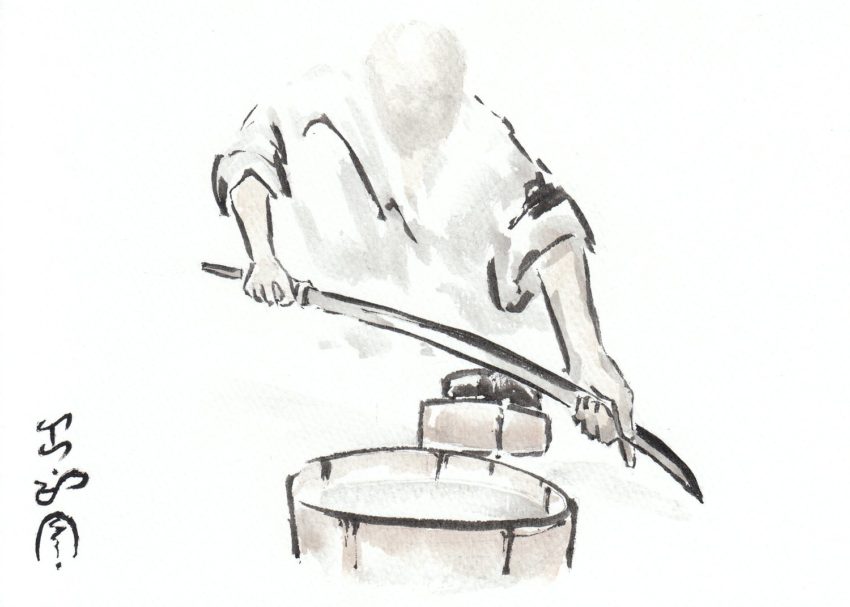After you’ve managed to snag an amazing deal on a true and worthwhile Japanese collectible, you may want to consider investing in some professional Japanese sword polishing. The process of polishing, when done the right way, should increase your collectible’s value in the long run. Even more importantly, polishing your sword helps preserve the blade for many years to come. Japanese swords have a long and storied history, in large part due to the careful attention paid to their care by the people who collect them.
Japanese Sword Polishing Through the Ages
Traditionally, Japanese sword polishing was a crucial element during the creation of a sword. A sword could not be considered “finished” until the sword smith had given the blade to a togishi. A togishi had the job of polishing the blade so that the natural beauty of the steel would be revealed to the world. This practice was necessitated by the folded steel method used to create Japanese blades. Togishi needed to have an eye for artistry and the inner essence of the blade, so that they could shape it into a deadly and beautiful weapon.
Togishi still hone their trade to this day. In fact, an apprentice may spend as many as ten years learning how to properly polish swords. The long apprenticeship reflects the tradition of Japanese sword polishing and respect for the artistry of the katana.
During the height of sword production in Japan, well before the modern era, samuraiSAMURAI 侍 "warrior serving a lord" learn more... would frequently damage their blades during battle. However, any damage would be almost immediately corrected, so that the blade could be restored to its prior beauty and ability. The honor of a samurai was inextricably bound to the state of his weapon. Modern Japanese sword polishing, therefore, continues this tradition of showing respect to values wrapped up in Japanese swords.
The Art of Polishing
The methods used to craft the blade of a traditional Japanese sword create a soft steel skin and hard edge, that when damaged requires the careful touch of a master togishi. Despite the fact that they ‘polish’ blades, a togishi’s primary role involves sharpening and shaping the blade in a way that restores it to its original shape and appearance.
Japanese sword polishing requires a complicated technique using many different stones to bring the shape out of the blade. The use of these special stones fall into two different types of polish.
Two Main Types of Polish
Shitaji: Foundation Polish
A foundation polish takes at least four to six days to complete, with an average 10 to 12 hours of labor. Togishi use six stones with varying coarseness:
- Bisui
- Kaisei
- Chunagura
- Komanagura
- Hato
- Jito
Each stone plays a different, but necessary, role in a foundation polish.
The steps involved in shitaji are meant to remove heavy rust, restore a blade’s original shape, and remove imperfections. Most of the stones involved in this process are terribly heavy and one wrong move could essentially destroy a blade. An amateur armed with Shitaji stones has the potential to sand an otherwise great sword to a paper-thin metal stick.
Shiage: Finish Polish
A finish polish uses tiny, thin stones and may take at least three days to complete. Techniques of finish polishing vary between different togishi, depending on the school with which they belong. All techniques, however use seven different stones:
- Tsuya
- Nugui
- Hadori
- Shitamigaki
- Uemigaki
- Sugikiri
- Narume
Before the steps of shiage, a Japanese sword will appear to have a matte finish. You could choose to stop at this point with a restored blade. However, for the sake of a collector’s item you will probably choose to “finish” the polishing so that the blade shines and the details of its edge stand out.
When Should A Sword Be Polished?
If you do acquire a decent authentic Japanese sword, you might want to consider several factors before rushing to get it polished. As one popular polisher based in the United States asserts, “no polish is always better than a bad polish.”
Noticeable flaws along the blade provide one major indication that you should send your sword for polishing. Flaws include chips or broken tips that noticeably mar the surface of the blade. These flaws should be handled by a professional to prevent further damage.
Another indication that your blade needs service are signs of active rust. This may mean a polish is immediately necessary, in order to prevent further degradation of the delicate layers of metal.
Finally, no matter the condition of your new sword, you need to take the cost of a professional polishing into consideration. If you already budgeted everything you had to buy your collectible, it may not be smart to seek a polishing service right away. A good, professional Japanese sword polishing service may take a pretty big chunk of change. Remember, the potential effects of not polishing your blade exponentially outweigh the potential damage that can be done by an amateur polisher or scam artist.
And if you do have the money to spend on a polish? Try getting an evaluation first. Giving your sword a new polish may not add as much value as you put into it.
Avoiding Con Artists
When it comes down to polishing collectible Japanese swords, you mainly should be concerned with being careful and decisive in your choices. Rushing into something in your excitement might potentially lead to you damaging your blade beyond recovery.
First, beware of amateurs who have no idea how to properly polish a Japanese sword. There are several telltale signs that can help you identify amateurs and scam artists. A huge red flag comes when anyone claims to be able to immediately work on your sword –there should ideally be a waiting list if they’re that good.
Other legitimate sword polishers list two or more weeks as their timeline per polish. When someone claims to be quicker, they are more likely to not use the proper, traditional methods. In addition, a polisher that doesn’t have a long waiting list most likely doesn’t have a good reputation.
Secondly, vet the polisher’s profile, especially those based in the United States. According to the official U.S. branch of the Society for the Preservation of Japan Art Swords, many people claiming to be an expert in polishing who live in the United States will not actually have proper training to do so.
Avoid Personal Damage
In addition to carefully choosing a polishing service, it is equally important to remember proper care when handling your sword personally. You should always avoid touching a polished blade, because your fingerprints may have a corrosive effect on the surface of the blade. Also avoid touching a polished blade with your clothing, which is both bad manners and damaging.
Ultimately, the action you should avoid at all costs is attempting to polish a blade on your own. Too many newcomers to collecting Japanese swords neglect to research the proper care for their collectibles. Many people who’ve heard the term “polish” try to buff their blade like jewelry or other common metal objects. Even if you are serious about learning how to polish swords using traditional methods, those techniques take years and years of careful study. Apprentices make many mistakes along the way. Now, if you wouldn’t want a green hairstylist hacking at your hair, would you want a green togishi butchering your blade for the sake of practice?
Conclusion: Weigh Your Options
The best togishi will wish to work with you and analyze your blade before deciding to even touch it. A Japanese sword is a major investment, as well as a piece of a noble history, too easily ruined by inexperienced hands.
Each authentic Japanese sword carries with it a lot of untold history. That people today even get to receive a glimpse into the past of the samurai and the development of Japanese weapons is a result of the careful preservation efforts of many people. Polishing a Japanese sword, as well as being an integral step in the creation of the blade, is an art form that seeks to renew beauty and majesty to old, tired blades.

